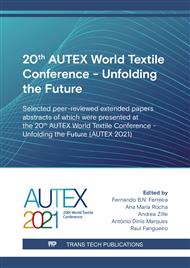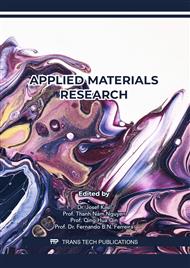p.133
p.139
p.147
p.157
p.163
p.171
p.177
p.187
p.195
Structural Engineering for Obtaining Functional Terry Towels
Abstract:
The mainstream to be achieved in the development of this scientific research was the development of terry towels based on structural engineering concepts, to increase durability and reduce weight. For this purpose, two different studies were conducted. One of them to evaluate the influence of the height of the loop – where the same height of the loop was kept – and the second prep to assess the impact of weight – in this part the produced terry structures presented similar aerial mass. These studies presented allowed a sample range of 14 different terry structures – all of them produced with a 100% cotton yarn (Ne 16), thus eliminating the parameter of influence of the raw material – that have been characterized in terms of mechanical, permeability, absorption, and capillarity properties, and subsequently compared to a standard terry towel (3-pick terry, 18 ends/cm, 411 gsm). Analyzing the study of the influence of the height of the loop it was possible to conclude that some variations can be introduced in terms of aerial mass by the change of weaving parameters, which resulted in aerial mass losses of up to 10% in some of the cases. Regarding the study of the impact of weight, was possible to verify that with a similar aerial mass between structures, the capillary and moisture release properties were increased by 19% and 12%, respectively.
Info:
Periodical:
Pages:
195-203
Citation:
Online since:
June 2022
Price:
Сopyright:
© 2022 Trans Tech Publications Ltd. All Rights Reserved
Share:
Citation:



